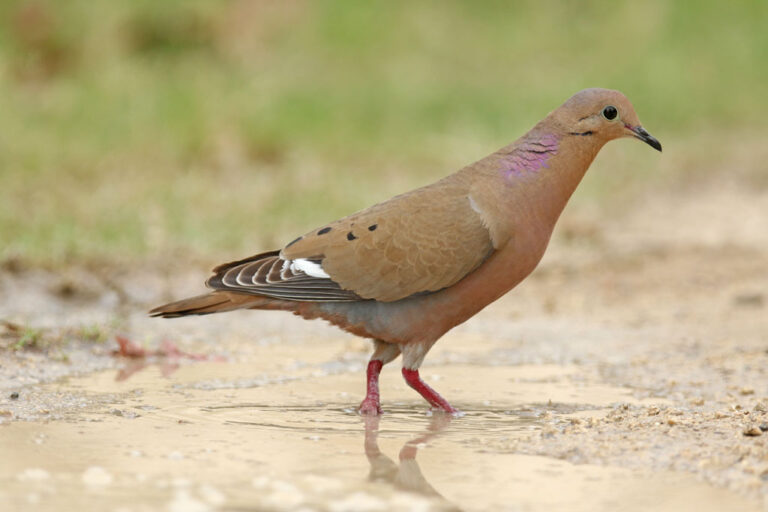Robin vs Cardinal: Key Differences Between These Birds
Did you know over 60 million American homes watch birds every year? The robin and cardinal are two birds that many people love to see. Knowing how to tell them apart can make bird-watching more fun. Robins vs Cardinals live in many parts of North America. But they are different in many ways. This section will help you learn about these differences. It will make it easier to spot these birds when you’re outside.
Physical Characteristics of Robins and Cardinals
Robins and cardinals are fascinating birds. They have different sizes, colors, and features. Let’s look at how big they are, their colors, and what makes them special.
Size Comparison
Robins are bigger than cardinals. Robins are about 10 inches long. Cardinals are about 8.75 inches long. This helps us tell them apart.
Color Patterns of Male and Female
Cardinals have bright red feathers. Females have brown and reddish colors. Robins have a black head, gray-brown body, and orange breast. These colors help us identify them.
Distinctive Features
Cardinals have a special crest on their heads. They also have conical beaks for seeds. Robins are sleeker with longer beaks for insects and berries. These features make each bird unique.
| Characteristic | Robins | Cardinals |
|---|---|---|
| Average Size | 10 inches | 8.75 inches |
| Male Coloration | Black head, gray-brown body, rust-orange breast | Bright red plumage |
| Female Coloration | Similar to male but with softer hues | Brown tones with reddish accents |
| Distinctive Features | Streamlined shape, longer beak | Crest on head, conical beak |
Habitat Preferences of Robins and Cardinals
Robins and cardinals have different homes. They live in places where they can find food and hide. This helps us understand where they live in North America.
Typical Environments
Robins like open places like grasslands and gardens. They also nest in trees or cities. This makes them very flexible.
Cardinals like it denser, like in shrubs and woods. They look for food and safety in thick bushes and trees.
Geographical Range
Robins are found all over North America, including Canada and Mexico. This shows how well they adapt.
Cardinals mostly live in the eastern United States. They like places with lots of plants. This helps them find food and a safe place to live.

| Bird Species | Preferred Habitat | Geographical Distribution |
|---|---|---|
| Robins | Open areas, gardens, parks, urban settings | North America, including Canada and Mexico |
| Cardinals | Dense shrubs, woodlands, bushy areas | Primarily eastern United States |
Diet and Feeding Habits
Robins and cardinals have special diets that help them survive. Each bird eats different foods because of their homes. This part talks about what robins and cardinals eat, showing how they get their food.
What Do Robins Eat?
Robins mainly eat insects and worms in spring and summer. They are great at finding worms in the ground. When it gets cold, they eat more fruits for vitamins and energy.
This change helps them live well in different places, like gardens.
Cardinal Diet Explained
Cardinals mostly eat seeds and fruits. But, they eat more insects in the breeding season. This gives them protein for their babies.
Cardinals have strong beaks for cracking seeds. Knowing this makes us appreciate backyard birds more.
Breeding and Nesting Behaviors
Robins and cardinals have interesting ways of making babies. They pick special places to nest and lay eggs. This makes us love these birds even more.
Nesting Locations
Cardinals like to nest in thick trees or bushes. They choose the height based on how many babies they have. The male sings to attract a female, making their love song.
Robins are flexible with where they nest. They might choose trees, bushes, or even human places like porches. This helps them take care of their babies well.
Egg Details
Cardinal eggs are light gray or green with speckles. Robin eggs are bright blue. These different colors make their eggs special and pretty.

| Species | Nesting Locations | Egg Appearance |
|---|---|---|
| Cardinal | Dense trees and shrubs | Light gray or green with speckles |
| Robin | Trees, shrubs, human-made structures | Bright blue |
Territorial and Social Behaviors
Robins and cardinals show different ways of living together and defending their space. Cardinals usually live alone and guard big areas. These areas can be as big as six acres, especially when they are making babies.
This shows how strong their need to protect their territory is. They become the leaders of their area during the breeding season.
Social Structures
Robins, on the other hand, like to be in groups. They form flocks in the winter. This helps them stay safe and talk to each other more.
Cardinals, however, stick to being in pairs or alone most of the time. Robins do better when they are with others.
Territory Size
Robins have smaller territories, usually less than half an acre. These territories often share borders with their neighbors. This makes their social world more open than the Cardinals’.
The size and shape of their territories show how different their social lives are. It also shows how they adapt to their surroundings.
Migration Patterns
Robin vs Cardinal have different ways of moving with the seasons. This shows how they survive and where they like to live. Each bird has its own way of dealing with the changing weather and breeding.
Do Robins Migrate?
Robins have their own robin migration patterns. They travel long distances with the seasons. In spring, they go north to breed in warm weather and find food.
In fall, they move south to avoid cold weather. But some robins stay in the south all year. They like the milder weather there.
Cardinals and Migration
Cardinals don’t migrate like robins do. They stay in the same place all year, mainly in the eastern United States. This lets them raise their young in the same area.
They adjust to the seasons without moving. They find food in their territory. This helps them save energy and breed well over time.
| Aspect | Robins | Cardinals |
|---|---|---|
| Migration | Migratory; moves north in spring, south in fall | Non-migratory; stays in the same area year-round |
| Breeding | Breeds in northern locations during migration | Breeds within established territory |
| Adaptation | Adapts by relocating for a better climate | Adapts to seasonal changes without moving |
Must Read: Why Do Birds Flap Wings Without Flying?
Communication and Sounds
Learning about bird talk helps us understand robins and cardinals better. They make different sounds for different reasons. This shows how complex their social lives are.
Distinctive Songs and Calls
Robins sing beautiful songs in spring. Their calls are clear and sound like a flute. This makes them sound very soothing.
Cardinals sing loud, clear songs. Males sing long melodies that can be heard far away. Females also sing, which is rare in birds. They use short calls to talk to each other.
Who Sings?
Robins mostly sing males. They sing to show they own the area and to find a mate. Their songs show they are healthy and strong.
Cardinals are different. Both males and females sing. This shows that both sexes play a part in their communication.
<h2>Robin vs Cardinal: Overview of Key Differences
Learning about <em>robin vs cardinal differences is more than just seeing colors. It’s about knowing the special traits of these birds. This part will show you the main differences between robins and cardinals. It will help you tell them apart and know more about them.
Summary of Differences
Robins and cardinals are different in many ways. They vary in size, color, what they eat, how they nest, and how they act in their territory. The table below makes it easy to see these differences.
| Characteristic | American Robin | Northern Cardinal |
|---|---|---|
| Size | About 9-11 inches long | Approximately 8.3-9.1 inches long |
| Coloration | Red-orange breast, brownish back | Bright red in males, tan-brown in females |
| Feeding Habits | Primarily insects, fruits, and worms | Seeds, fruits, and insects |
| Nesting Preference | Nests on branches, shrubs | Nests often in dense shrubbery or trees |
| Territorial Behavior | Establishes territories during breeding season | Highly territorial, especially during nesting |
Visual Identification Tips
To spot these birds in your yard, follow these tips:
- Look for the robin’s orange-red breast against its brown back.
- Spot the male cardinal’s bright red feathers. The female has a crest and less bright colors.
- Watch how they eat. Robins search on the ground, while cardinals eat from high spots.
- Check where they nest. Robins like open spots, while cardinals nest in shrubs.
Conclusion
Robin vs Cardinal is interesting to watch. They look different and sing unique songs. These differences make birdwatching more fun.
Robins and cardinals have special traits. The male cardinal is bright red, and the robin has an orange breast. They build nests and eat in different ways.
Learning about these birds makes watching them better. It helps you see nature’s beauty closer to home. So, get your binoculars ready and start exploring!
Frequently Asked Questions
Q1. What are the main differences between Robins and Cardinals?
Robins are medium-sized birds with orange-red breasts and gray-brown bodies, while cardinals are vibrant red (males) or tan with red highlights (females) with a distinct crest on their heads.
Q2. How can you tell a robin from a cardinal?
Robins have a rounder body, orange-red breasts, and no crest, whereas cardinals are slenderer and have a prominent crest, and the males are bright red with a black facial mask.
Q3. What does it mean to see a robin vs. a cardinal spiritually?
Seeing a robin often symbolizes renewal, joy, and new beginnings, while a cardinal is associated with loved ones watching over you, spiritual guidance, and vitality.
Q4. Are robins or cardinals more common in gardens?
Both are common, but robins are often seen hopping on lawns in search of worms, while cardinals are more likely to visit feeders, especially in wooded or shrub-filled areas.
Q5. What are the symbolic meanings of robins and cardinals?
Robins symbolize hope, transformation, and the arrival of spring, while cardinals represent loyalty, love, and spiritual connection with the divine or departed loved ones.
Q6. How do the songs of robins differ from cardinals?
Robins have a melodic, cheery song often described as “cheerily, cheer up,” while cardinals have a sharper, whistling tune, often sounding like “cheer-cheer-cheer” or “birdie-birdie-birdie.”
Q7. Which is more territorial: Robin vs Cardinal?
Both are territorial, but robins are particularly aggressive during the breeding season, fiercely defending their nesting areas, while cardinals are more territorial year-round around food sources.







